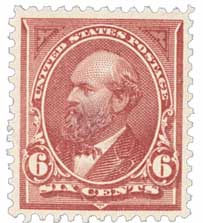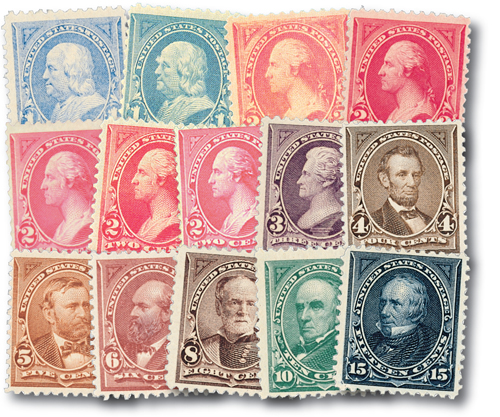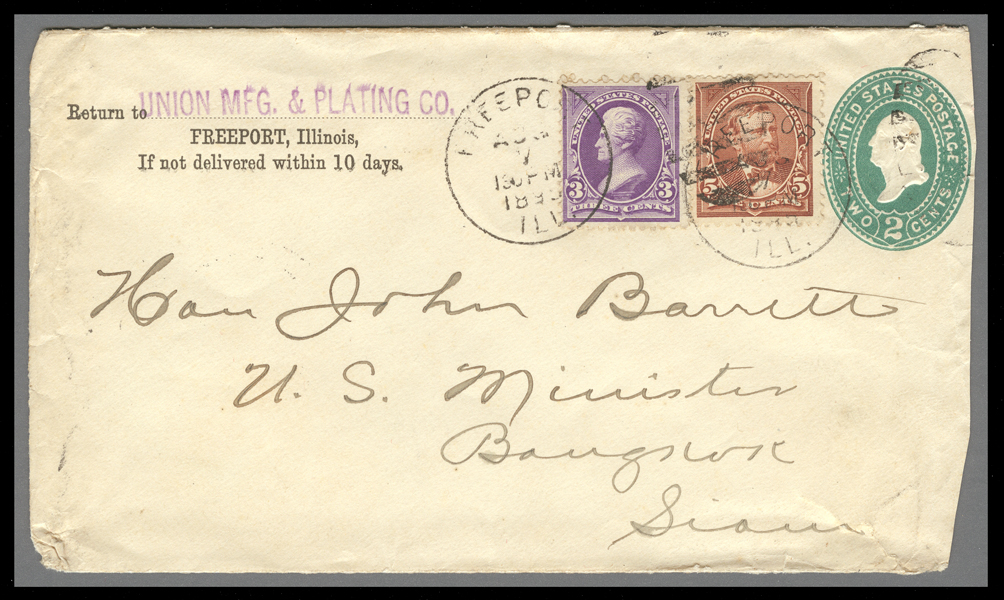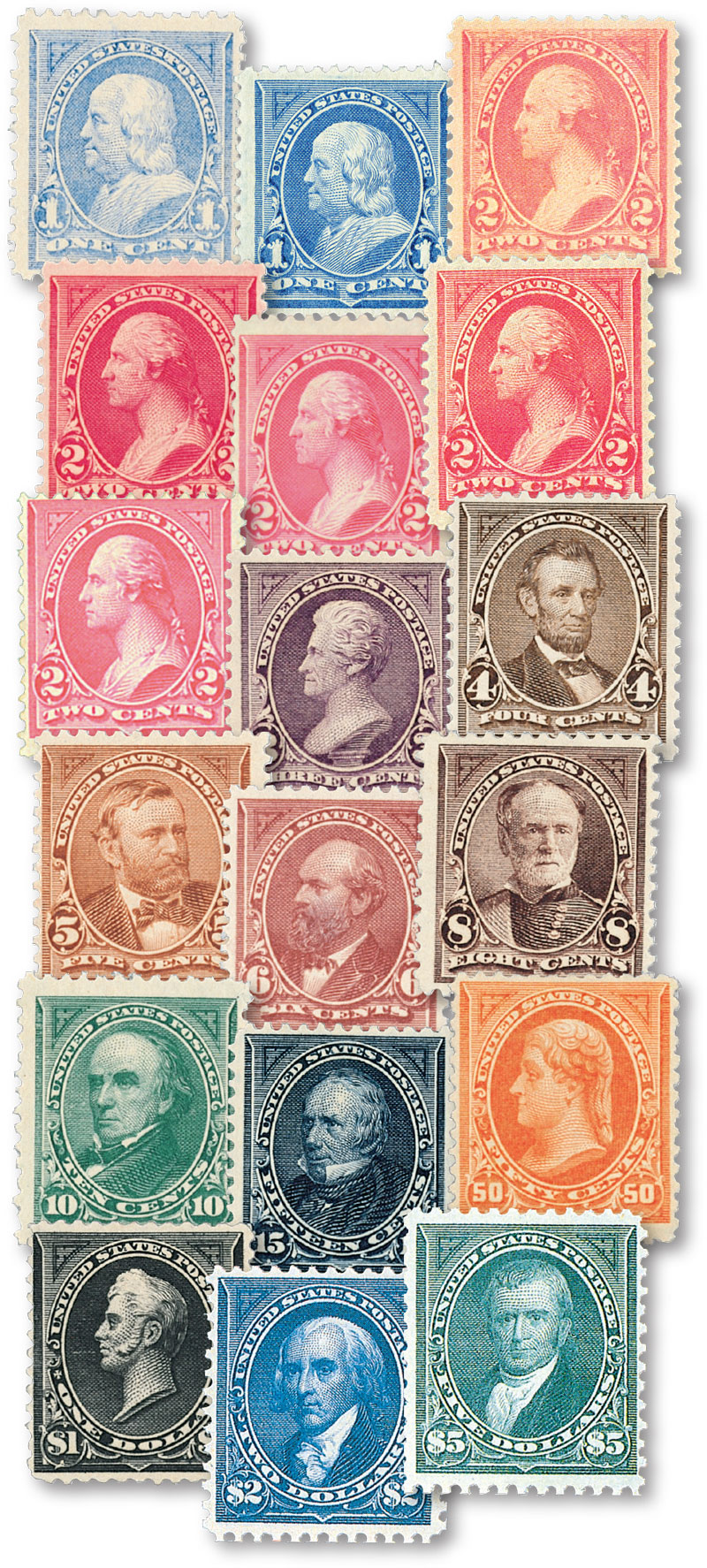
1894 6¢ Garfield
Issue Quantity: 5,120,800
Printed by: Bureau of Engraving and Printing
Watermark: None
Perforation: 12
Color: Dull brown
The 1894 6¢ Garfield stamp was the first of its series to be issued.
First BEP Postage Stamp

On July 18, 1894, the post office issued the first US postage stamp printed by the Bureau of Engraving and Printing (BEP).
The BEP was established in 1862, following the outbreak of the Civil War. When the firing on Fort Sumter began, the nation was already on the verge of bankruptcy and was in no position to finance a war. This matter, along with other war issues, prompted President Lincoln to call a special session of Congress. During this session, secretary of the Treasury Salmon P. Chase suggested issuing noninterest-bearing notes that would circulate as money and a system of domestic taxation.
Congress adopted the Chase plan, and as a result, the first government-issued paper money came into existence. That same year, the president appointed a commissioner of internal revenue, who was given the authority to assess, levy, and collect taxes. Items such as medicine, perfume, cosmetics, alcohol, and tobacco were taxed, and stamps were provided as proof of collection of the tax. The BEP began by printing only the beer and cigar stamps, but by 1878, nearly all revenue stamps were produced by them.

In 1894, with the approval of the secretary of the Treasury, the Bureau submitted a bid for the contract to print the new series of postage stamps. Their bid was almost $7,000 less than the lowest bid submitted by the three private companies also competing for the contract. Until this date, contracts had been awarded to private companies for the production of stamps. Despite loud protests that the Bureau was not capable of producing the stamps, they were awarded the contract.

The BEP used the same dies previously used by the American Bank Note Company for their first series of stamps but made small changes to them so the stamps could be distinguished from the previous issues. The BEP printed its first postage stamps on July 1, 1894. The very first stamp produced by the BEP was #256, the 6¢ Garfield, issued less than three weeks later on July 18.

That stamp marked the start of the first Bureau Issue. Throughout 1894, the BEP would print stamps in 13 more denominations, though some color differences and slight changes to the printing plates resulted in several varieties of some of the stamps. The following year, the BEP printed the same designs on double-line watermarked paper, to help prevent counterfeiting.

Soon, the BEP began producing most US postage stamps. In the coming years, there were several major milestones. The BEP produced its first coil stamps in 1908, first used the rotary press in 1914, and began experimenting with electronic controls in the perforating process. During World War II, the BEP produced Allied military stamps that were used in Italy, France, Germany, and Austria. The BEP printed its first full-color stamp on the Giori Press (#1094) in 1957.
For about 75 years, the BEP produced nearly all US postage stamps (except for the 1943 Overrun Countries printed by the American Bank Note Company). This began to change in the late 1960s when the US Post Office began issuing contracts to private security printers. BEP stamp production dropped significantly, to less than 50% of all stamps in 1997. The last BEP-produced stamp was #3632, printed for the last time on June 10, 2005.
Click here to view and order the First Bureau Issue singles.
1894 6¢ Garfield
Issue Quantity: 5,120,800
Printed by: Bureau of Engraving and Printing
Watermark: None
Perforation: 12
Color: Dull brown
The 1894 6¢ Garfield stamp was the first of its series to be issued.
First BEP Postage Stamp

On July 18, 1894, the post office issued the first US postage stamp printed by the Bureau of Engraving and Printing (BEP).
The BEP was established in 1862, following the outbreak of the Civil War. When the firing on Fort Sumter began, the nation was already on the verge of bankruptcy and was in no position to finance a war. This matter, along with other war issues, prompted President Lincoln to call a special session of Congress. During this session, secretary of the Treasury Salmon P. Chase suggested issuing noninterest-bearing notes that would circulate as money and a system of domestic taxation.
Congress adopted the Chase plan, and as a result, the first government-issued paper money came into existence. That same year, the president appointed a commissioner of internal revenue, who was given the authority to assess, levy, and collect taxes. Items such as medicine, perfume, cosmetics, alcohol, and tobacco were taxed, and stamps were provided as proof of collection of the tax. The BEP began by printing only the beer and cigar stamps, but by 1878, nearly all revenue stamps were produced by them.

In 1894, with the approval of the secretary of the Treasury, the Bureau submitted a bid for the contract to print the new series of postage stamps. Their bid was almost $7,000 less than the lowest bid submitted by the three private companies also competing for the contract. Until this date, contracts had been awarded to private companies for the production of stamps. Despite loud protests that the Bureau was not capable of producing the stamps, they were awarded the contract.

The BEP used the same dies previously used by the American Bank Note Company for their first series of stamps but made small changes to them so the stamps could be distinguished from the previous issues. The BEP printed its first postage stamps on July 1, 1894. The very first stamp produced by the BEP was #256, the 6¢ Garfield, issued less than three weeks later on July 18.

That stamp marked the start of the first Bureau Issue. Throughout 1894, the BEP would print stamps in 13 more denominations, though some color differences and slight changes to the printing plates resulted in several varieties of some of the stamps. The following year, the BEP printed the same designs on double-line watermarked paper, to help prevent counterfeiting.

Soon, the BEP began producing most US postage stamps. In the coming years, there were several major milestones. The BEP produced its first coil stamps in 1908, first used the rotary press in 1914, and began experimenting with electronic controls in the perforating process. During World War II, the BEP produced Allied military stamps that were used in Italy, France, Germany, and Austria. The BEP printed its first full-color stamp on the Giori Press (#1094) in 1957.
For about 75 years, the BEP produced nearly all US postage stamps (except for the 1943 Overrun Countries printed by the American Bank Note Company). This began to change in the late 1960s when the US Post Office began issuing contracts to private security printers. BEP stamp production dropped significantly, to less than 50% of all stamps in 1997. The last BEP-produced stamp was #3632, printed for the last time on June 10, 2005.
Click here to view and order the First Bureau Issue singles.















